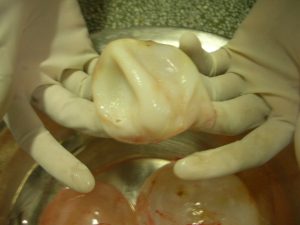 Echinococcus granulosus is a tiny tapeworm responsible for causing hydatid disease, also known as cystic echinococcosis. This parasitic infection typically occurs when humans accidentally ingest tapeworm eggs, often through contaminated food, water, or contact with infected animals, particularly dogs, which are the definitive hosts of the parasite. The intermediate hosts are usually livestock, such as sheep and cattle, which harbor the larval stage of the parasite.
Echinococcus granulosus is a tiny tapeworm responsible for causing hydatid disease, also known as cystic echinococcosis. This parasitic infection typically occurs when humans accidentally ingest tapeworm eggs, often through contaminated food, water, or contact with infected animals, particularly dogs, which are the definitive hosts of the parasite. The intermediate hosts are usually livestock, such as sheep and cattle, which harbor the larval stage of the parasite.
Once inside the human body, the eggs hatch and the larvae travel through the bloodstream, commonly lodging in the liver and lungs, where they form fluid-filled cysts. These cysts can grow slowly over many years and cause symptoms depending on their size and location. In the liver, they may cause abdominal pain, nausea, and jaundice, while in the lungs, they can lead to chest pain, coughing, and shortness of breath. If the cysts rupture, they can cause severe allergic reactions or secondary infections.
Diagnosis often involves imaging techniques, such as ultrasound or CT scans, to detect cysts. Treatment depends on the size and location of the cysts and may involve surgical removal, antiparasitic medications (like albendazole), or a less invasive procedure called PAIR (Puncture, Aspiration, Injection, and Re-aspiration).
Preventing hydatid disease involves controlling the transmission cycle, particularly by deworming dogs and avoiding feeding them raw offal from livestock. Additionally, good hygiene practices, including handwashing and food safety, can help reduce the risk of infection.



